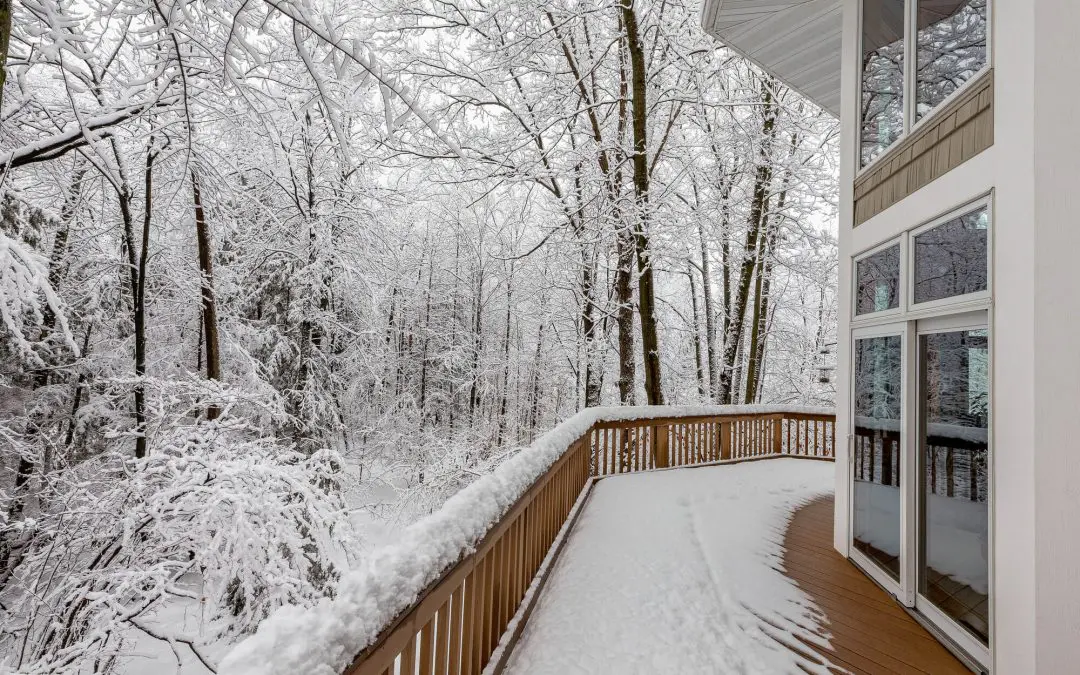As the winter months approach, it’s important to prepare your deck for the harsh elements that come with colder weather. Snow, ice, and freezing temperatures can cause significant damage to your deck if it’s not maintained and protected. Winterizing your deck will keep it in good condition, preserving its appearance and structural integrity. In this guide, we’ll discuss key steps to winterize your deck to help you avoid expensive repairs so your outdoor space is ready to use when warmer weather returns.
Clean Your Deck Thoroughly Before You Winterize Your Deck
The first step in winterizing your deck is to give it a deep clean. Dirt, leaves, and other debris trap moisture, leading to mold growth and potential wood rot. Start by sweeping the entire surface to remove loose debris, and use a hose or pressure washer to get rid of stubborn dirt. Pay attention to the spaces between deck boards, as leaves and dirt can accumulate there, creating the perfect environment for moisture to build up.
For decks that show signs of mold or mildew, use a deck cleaning solution designed for wood or composite materials. Scrub the deck with a stiff brush, focusing on areas where mold is visible. Once the deck is clean, let it dry completely before moving on to the next step.
Apply a Water-Repellent Sealer When You Winterize Your Deck
One of the most important steps in winterizing your deck is protecting it from moisture. Water can seep into the wood, causing it to expand, crack, or warp as temperatures fluctuate. To prevent this, apply a high-quality water-repellent sealer or stain for decks.
Before applying the sealer, make sure the deck is completely dry. Depending on the climate, this may take a day or two after cleaning. Follow the manufacturer’s instructions for applying the product, using a brush, roller, or sprayer. Be thorough in covering the entire surface, including the railings and steps.
For best results, apply the sealer at moderate temperatures. Avoid sealing your deck if it’s too cold or damp, as this will affect how well the product adheres to the wood. Once the sealer is applied, allow it to cure fully, which may take a few days, depending on the product.
Protect Furniture and Accessories
Outdoor furniture, planters, and other accessories contribute to deck damage during the winter if left exposed. Moisture can seep into furniture, causing rust or rot, while heavy snow puts extra pressure on the deck’s surface. To protect your deck and your outdoor items, remove furniture and accessories before the first snow or heavy rain.
If you prefer to leave furniture on the deck, cover it with weather-resistant covers. This will shield it from moisture and prevent it from scratching or damaging the deck surface as it shifts during the winter months. Be mindful to check under the covers occasionally for trapped moisture, which can lead to mold growth.
Plan for Regular Maintenance After You Winterize Your Deck
Winterizing your deck isn’t a one-and-done task. It’s important to plan for regular maintenance throughout the winter months to keep your deck in optimal condition. After heavy snowfalls, clear the surface and check for signs of damage, such as cracking or warping. If your deck is located in an area that experiences frequent freezing and thawing cycles, inspect it more often to catch potential issues early. Regular maintenance will keep your deck strong and beautiful, no matter how harsh the weather.
Winterizing your deck is a crucial step in maintaining its longevity and safety. With these tips in mind, you’ll be well-prepared for the colder months ahead. Remember to clear snow and ice regularly and keep an eye on drainage to prevent moisture buildup. With proper care and attention, your deck will remain in great shape, ready to welcome warmer days once winter is over.
FAQs
Can I use snow blowers or other heavy equipment to clear snow from my deck?
It’s generally not recommended to use snow blowers or heavy equipment on a deck. Snow blowers, especially the larger models, can cause physical damage to deck boards, railings, and even the supporting structure. Instead, stick to using lightweight tools like a plastic shovel or a broom to gently push the snow off the deck. If you have to deal with thick ice, use a plastic ice chopper designed for delicate surfaces.
Do decks with outdoor kitchens or fire pits need special attention before winter?
Yes, if your deck has an outdoor kitchen, fire pit, or other built-in features, winterizing these elements is also important. Confirm that all appliances are properly covered, turned off, and disconnected if necessary. For fire pits, remove debris and clean out the ash to prevent it from damaging the deck. Invest in a cover for the fire pit to keep it dry and free of snow. If the fire pit or kitchen is built into the deck, inspect the area around it for cracks or wear that could lead to damage from water or heat fluctuations.
Is there a difference in winterizing a pressure-treated wood deck versus natural wood?
Pressure-treated wood is designed to resist rot and decay, but it still requires winter maintenance. Like natural wood, pressure-treated decks need to be cleaned and sealed before winter. However, the frequency of sealing may differ. Pressure-treated wood typically requires sealing less often than untreated wood, but it’s still a good idea to check the condition of the deck each year and apply a water-repellent sealer as needed. This protects the wood from excessive moisture absorption, even with the built-in treatments.
If you’re buying or selling a home in the Chicago area, contact Danny Inspections. We offer comprehensive home inspection services. Contact us today to schedule an appointment.

